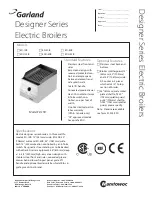
26
1. Hand over the copy of the End User Instructions supplied
with the appliance, together with these instructions, and
explain how to use the timeclock and room thermostat.
2. Show the End User how to switch the appliance off
quickly, and indicate the position of the electric supply
isolator.
3. Inform the End User of the location of all drains, isolating
valves and air vents.
4. Explain how to turn the appliance off for both short and
long periods and advise on the precautions necessary to
prevent damage in the event that the appliance is
inoperative when freezing conditions occur.
5. Instruct the End User on the correct procedure for
checking and refilling the boiler.
6. Finally advise the End User that, for continued safe and
efficient operation, the appliance must be serviced by a
competent person at least once a year.
3.10
I
NSTRUCTING
T
HE
E
ND
U
SER
D
RAINING THE
H
EATING
S
YSTEM
The heating system must be drained as follows:
-
Turn off the boiler;
-
Attach a hose pipe and open the drain valve;
-
Drain the system at the lowest points (where present).
When the heating system is unused for an extended
per iod of time, it is recommended that you add
antifreeze with an ethylene glycol base to the water in
the heating pipe work and radiators if the ambient
temperature drops below 0°C during the winter.
This makes repeated draining of the entire system
unnecessary.
D
RAINING THE
D
OMESTIC
H
OT
W
ATER
S
YSTEM
Whenever there is the danger of the temperature
dropping below the freezing point, the domestic hot
water system must be drained as follows:
-
Turn off the general water valve for the household
plumbing system;
-
Turn on all the hot water taps;
-
Empty the remaining water from the lowest points in the
system (where present).
3.7
D
RAINING THE
S
YSTEM
3.8
C
OMPLETION
For the Republic of Ireland it is necessary to complete a
“Declaration of Conformity” to indicate compliance to I.S.
813. An example of this is given in the current edtion of I.S.
813. In addition it is necessary to complete the
Log Book.
3.9
O
PERATIONAL
C
HECKS
1. The flue system must be visibly checked for soundness.
2. On Central Heating allow the system to warm up and
adjust the Central Heating temperature control knob,
check the burner modulates up and down between the
high and low settings.
3. Range rate the thermal power for Central Heating, as
detailed in
S
ECTION
4.2, Page 29.
4. Run the Domestic Hot Water and adjust to the correct
water flow rate, adjust the Domestic Hot Water
temperature control knob to check the burner modulates
up and down between the high and low settings.
5. Balance the Central Heating system until all return
temperatures are correct and equal.
6. Turn the ON/OFF button OFF, disconnect the pressure
Gauge, retighten screw and relight boiler.
7. Re-examine Central Heating, Domestic Hot Water and
Cold Water supplies for soundness.
8. Check the appearance of the gas flame to assess the
adequacy of the combustion air supply.
9. If external controls have been disconnected, reconnect
and test.
10. Refit boiler casing.
















































